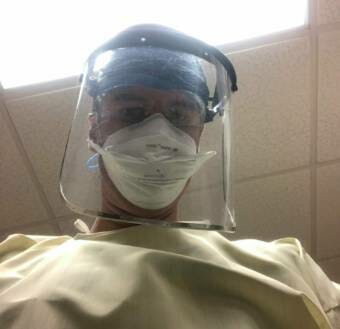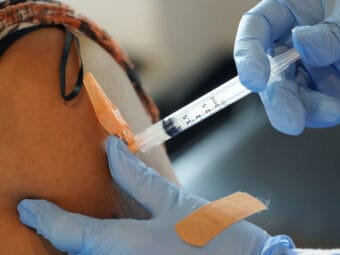
Alaska is seeing some of its highest case numbers of the entire COVID-19 pandemic, and its hospitals are full.
Doctors and nurses have described hours-long waits for care in the emergency room, as a wave of COVID-19-infected patients collides with already high summer demand on hospitals from tourists and trauma victims.
At the same time, Alaska’s health care system is contending with a staffing shortage that’s forced doctors and nurses to work extra shifts in a psychologically draining environment — one where part of their job is caring for acutely sick unvaccinated coronavirus patients, whose most serious problems likely could have been averted by the vaccine.
After weeks of increasing pressure on health care workers, cases numbers and hospitalizations don’t yet show signs of slowing down. And at the same time, multiple Alaska school districts, including in the Mat-Su, are allowing students to return to classrooms without masks — described by public health professionals as one of the most effective tools to mitigate the coronavirus’ spread.
At a state-sponsored briefing for Mat-Su parents Thursday night, one doctor’s frustration stood out. Over the course of six minutes, Tom Quimby, 42, implored parents to get their children vaccinated and described watching unvaccinated COVID-19 patients die in his emergency department in the Mat-Su — a region where just 42% of eligible residents have gotten at least one shot, the third-lowest rate in the state.
Listen here:
Quimby’s remarks are transcribed below in full.
Thanks for having me on tonight. I’m a Mat-Su Borough school parent of two children, the medical director of the emergency department at Mat-Su Regional (hospital), and been really involved in the COVID task force at the hospital.
[Alaska Chief Medical Officer Dr.] Anne [Zink] asked me a couple hours ago if I could join this meeting tonight, and I’m here with some reluctance. I’ve done a lot of talking about COVID, and I think like the rest of you, we’re all kind of tired of hearing about it, and we wish it would go away. But clearly, it’s not.I’ve thought about what I could do to provide useful information in about five minutes tonight. I think probably the most helpful thing that I can do is provide a little bit of insight as to what is happening in our medical system in our community. And the situation is not good, and it’s growing worse every day.
Over the last month, we’ve started experiencing a surge of COVID patients on top of a surge of many other medical problems. The medical system had seen decreased volumes — we believe because a lot of people were scared to come and interface with the medical system and come to the hospital over the last year. And those people have all come back, and we are seeing record numbers of patients in our emergency departments and hospitals in the Anchorage Bowl, and that’s the same that we’re seeing in Mat-Su.
This surge started, the Anchorage hospitals had been at capacity. Their ICUs have been full now for a couple of weeks. We’ve been getting transfers to Mat-Su from places like Kotzebue, Cold Bay, all over across the state, which is something that never happens, because they cannot accept these patients in Anchorage.
We’ve been fortunate to have capacity in the last week. That is rapidly changing in our hospital. I’ve worked almost every day over the last week in the emergency department, including this morning. We have been seeing extremely ill patients with COVID. They are all unvaccinated, the ones that I’ve seen. There are some reports of some [vaccinated, hospitalized] elderly people, who are not going to mount a good immune response, who have been sick. But for the most part, all of these young people — including a girl in her twenties that I saw as I was walking out of the emergency department, who had oxygen levels in the fifties — they’re all unvaccinated.
I’ve been putting breathing tubes in patients almost every shift. Our ICU has a capacity of 16 beds. The only reason we haven’t filled it up is because people have been dying and opening beds up. And I wish I had something different to tell you.
Our health care staff is really burned out. I’ve had a number of nurses come up to me that I’ve worked with for a number of years, and they’ve told me that they will be leaving the field. We’ve had a number leave the department, and the staffing shortages are only making things worse.
I just — I wish that some time you could come and stand with me over a patient who is taking some of their last breaths, and they have an oxygen level of 20%. Like the 40-year-old father I put a breathing tube in yesterday. Me standing over him is probably the very last thing this man will ever see in his life. And that is devastating. And it’s tragic. And it is — I just can’t even describe what that feels like to be a part of that. And to know at this point, based on all of the data that’s been presented here by Dr. Zink, as well as in so many places, that this is a vaccine-preventable illness.
So, I guess I would ask what has already been asked tonight. We know that there are effective tools. You might be asking, “Why do we care? This is happening in the hospital. These are older people. These are not children.” We know that our community and our schools — they’re not separate. There’s not a wall between our children and the other people in our community. And as has been expressed, we are seeing younger people getting sick. But the problem is that these children go back to their families. And we’ve seen in many other communities that our schools, if we get out-of-control spread that affects the rest of the community, that it can overwhelm the health care system [and] has very negative consequences for the entire community.
We know, from a year and a half of this happening across the entire world, with mountains of data, what works. And we know, in this community, that masks are a very important tool. I applaud the school district and their efforts last year. My own children were able to be at school, which is very important. I only partially send my children to school for their academic education — I want them to get a social education. I wanted them to be involved in extracurricular activities and sports. And this school district was able to very successfully do that. And it was very clear from the data set from this school district, that any and almost all outbreaks that occurred were in situations where people weren’t wearing masks. The data from this district is unequivocal in demonstrating the effectiveness of masks.
In our ER group, where we’re living in this daily, putting breathing tubes into people who are incredibly sick, not a single ER doctor in our entire group, ever, has contracted COVID, thanks to the use of masks. We also know now — and I don’t want to belabor this — the vaccines are incredibly effective. By the day, they are showing to be safe, and they continue to be effective.
And I would implore people — I know people don’t [want], and I don’t want, to be forced or mandated to do things. But choose to make a personal choice, for your children, for your family, for your teachers in your community, to please consider wearing a mask and vaccinate, vaccinate your children and your family. And I hope — I know so many people have made their mind up about this. But I just want to share with you what I’m seeing here in our community. And I hope that this can help maybe persuade a person here or there at this point. So, thank you for your time.
Editor’s note: A previous version of this transcript transposed two paragraphs. This has been amended.



